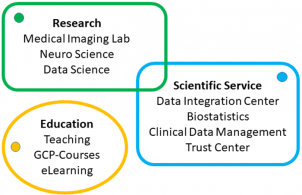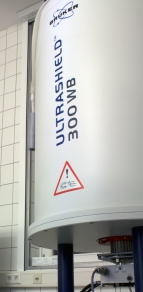Profile

Medical Informatics
Medical Informatics
Medical Informatics concerns the planning and development of health information systems as well as designing e-learning and grid computing solutions. In the field of magnetic resonance imaging and spectroscopy, experimental MRI involves the introduction, use and optimisation of new mensuration apparatus and methods. The Neuroimaging research group is focused on functional and structural brain imaging approaches based on magnetic resonance imaging. In particular, research is being conducted into ways of visualising nerve fibers and brain-computer interfaces using real-time fMRI.
Molecular MR analysis and imaging
In addition to image processing, signal processing is one of the main areas of research in the field of health informatics and encompasses signal generation, detection and processing as well as the corresponding analyses. All diagnostic methods are based on the detection of a specific variable (charge, nuclear spin, absorption/transmission, density, etc.). MR analytics and imaging is about using these properties to extend existing diagnostic methods, whereby the primary focus is on magnetic resonance (MR) procedures. The Otto von Guericke University Magdeburg’s Institute for Biometry and Medical Informatics (IBMI) has set itself five research priorities in this field:
1. Active ingredients and contrast media
Detecting molecules in a physiological environment often presents a major challenge: samples can change as a result of such things as oxidation processes and the detection limits of the markers to be examined can be too low, which is why, for example, one component of new contrast agents are heterocores. This requires new pulse programmes and the adaptation of image processing methods. . More ...
2. Developing molecular temperature probes
Numerous biochemical processes are influenced by temperature. Inflammations, for example, are associated with an increase in temperature. Yet, local in vivo measurements often turn out to be non-trivial. However, it is also possible to determine "temperature", as a variable indirectly using parameters such as image contrast or the chemical displacement of an MR signal. More ...
3. Hyperpolarisation
One major disadvantage of magnetic resonance approaches is their lack of sensitivity: so-called hyperpolarisation techniques are used to reduce the measurement period and increase sensitivity. The field of health informatics involves writing new pulse programmes as well as adapting existing ones. More ...
4. Low-field MR spectroscopy
By contrast with high-field MR spectroscopy, low-field MR spectroscopy combines all detected signals of a given isotopic type; chemical displacements play no role, in addition to which the detection limit is increased. Nevertheless, simulating the recorded data could identify substance/sample-specific patterns and appropriate data analysis programmes need to be written. More ...
5. Developing new MR coil systems
The research group has set itself the goal of furthering the development of high-field MRI systems, with a particular focus on simulation-supported MR coil development. MR coils are the metrological interface between man and machine, providing non-invasive insight into the human body. More ...
Neuroimaging
Realt-time fMRT
Real-time fMRI makes it possible to analyze a test subject’s brain activation during a functional MRI scan. This technology enables, for example, brain-computer interfaces, which are used for neurofeedback or for controlling external systems, to be implemented. More ...
Brain-Computer Interfaces for Navigating in Virtual Realities
The aim of this project is the design and implementation of a VR (virtual reality) stimulus environment for real-time fMRI studies. In this connection, Virtual Reality means a computer-simulated environment, which conveys synthetic experiences to its users. In this way, this deeper visualization aims to represent everyday processes more realistically and to increase the attention of the test subject through more interaction with the paradigm. More ...
Diffusion Tensor Imaging (DTI)
DTI is used to map the movement of water molecules in tissues. Through further calculations, nerve fiber orientations can be illustrated in strongly anisotropic tissues such as the white matter in the brain. More ...
Information sytems
Scientific computing
The aim of scientific computing in medicine is to provide high-performance computing resources for medical informatics, biometrics and neurosciences. The server farm, consisting of eight Apple Xserves with Mac OS X.5 and 16 HP Blades with Suse Linux 11.1 was configured as a computing cluster for calculations using high-dimensional MRI data. Alongside the server farm, the institute’ own computer pool with 26 computers each with 4 CPUs is also used for calculations. More ...
E-learning
In the framework of the e-learning program in the Faculty of Medicine at the University of Magdeburg, our institute is engaged in creating and implementing concepts for case-based learning and the introduction of a collection of teaching images. More ...
Biometry
Teaching and consultancy work are the primary focus of the Biometry working group.
Biometric consulting for medical research projects is available to all members of the University of Magdeburg’s Faculty of Medicine. Advice is available for experiment planning, data acquisition, statistical analysis and interpretation of results. It comprises support with
- scientific papers (doctoral/professorial theses),
- medical publications,
- applications for animal experiments and
- clinical studies.
The group has close cooperative relationships, in some cases built up over many years, with a multitude of institutes and clinics in the Faculty of Medicine. These cooperations frequently grow out of the consulting services provided by the working group, after which more extensive work is undertaken by us, which is frequently connected with the planning and analysis of clinical or experimental studies. The significance of this work to our group can be seen from the list of publications by the Institute, which contains many papers that were born out of the close cooperation with partners in the faculty.
Close cooperative relationships also exist with the Coordination Center for Clinical Studies (KKS) Magdeburg, which was established with support from the Institute for Biometry and Medical Informatics.
Equipment and competencies
The institute is equipped with the following special devices:
NMR spectrometer Bruker WB-300 Ultrashield |
Linux-Cluster |
||
|
|
Bruker 7T NMR spectrometer with 10 mm sample head Routine measurements: 1D NMR spectra of nuclei: 1H, 13C, 19F |
|
Hybrid server farm consisting of:
|
3D printer |
|||
|
Fused Deposition Modeling 3D printer:
|
|||
Members of the institute have access to the following human MRI systems:
7 tesla ultra-high field whole body MRI system |
3 tesla ultra-high field whole body MRI system |
||
|
|
|
||
|
Siemens TIM Avanto (Operator: FNW) Equipment:
|
|||
Biometry
Biometry offers a statistical consulting service for the support of medical research and doctorates on the campus. Where required, the statistical evaluations are done with SPSS, SAS and JASP and also R and Matlab. The Query and G*Power programs are used for sample size planning and power analysis.










